Chile's 33 miners still haunted by their past
- Published
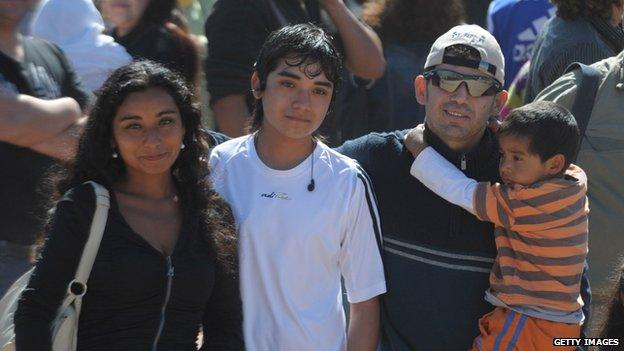
Alex Vega (right) says he cannot remember the birth of his children
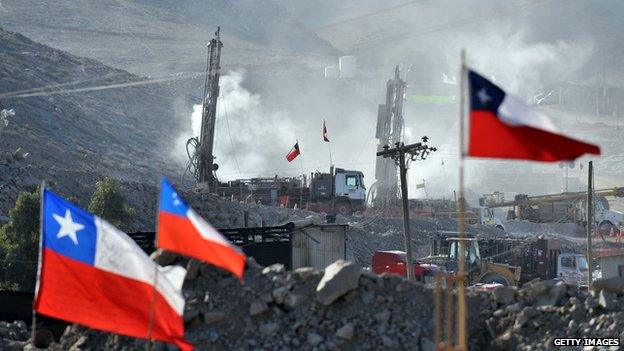
The miners spent 69 days underground before a drill reached them and they could be rescued
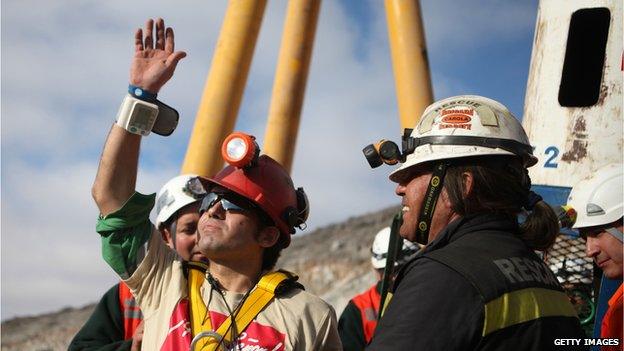
The 10th miner to be rescued, Alex Vega still has nightmares about being trapped underground
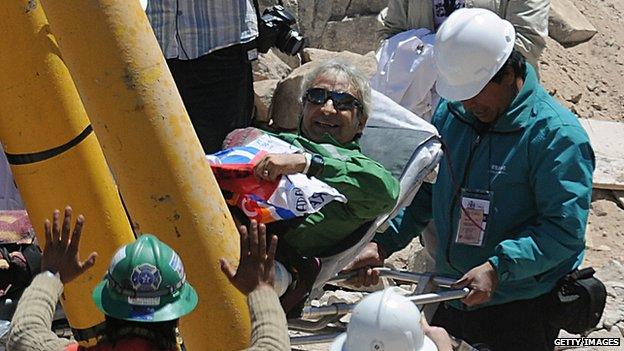
Omar Reygadas says big mining companies are reluctant to hire him
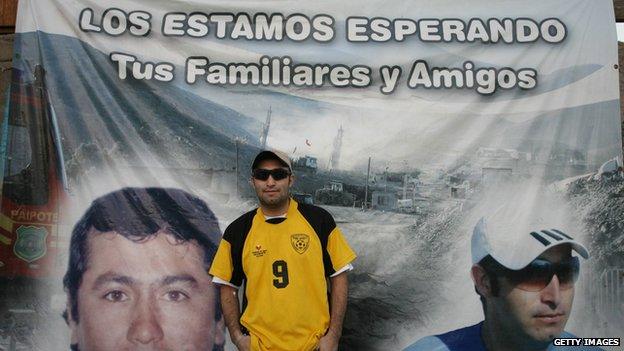
Carlos Barrios says he was fine for the first two years after the rockfall, but then suffered a relapse
Alex Vega was present at the birth of his three children but cannot remember being there.
He forgets things, cannot concentrate and suffers mood swings. He is seeing a psychiatrist and is on medication.
More than three years after he and 32 other miners were rescued from the San Jose mine underneath Chile's Atacama Desert in a story that captured the imagination of the world, Alex still has nightmares.
"I'd wake up thinking I was inside a mine," he told the BBC.
"I'd wake up shouting. I said to myself 'I have to deal with this' so for a week I went back down a mine owned by my brother-in-law. Each day I'd go a little bit further inside, to overcome the fear. These days I have far fewer nightmares."
'We are all OK'
The tale of Chile's 33 miners was one of the most momentous news stories of 2010.

The note is now in a museum in Copiapo
In August of that year, the San Jose mine collapsed, trapping the men 700m (2,300ft) below ground.
Nothing was heard from them for 17 days and most people assumed they were dead.
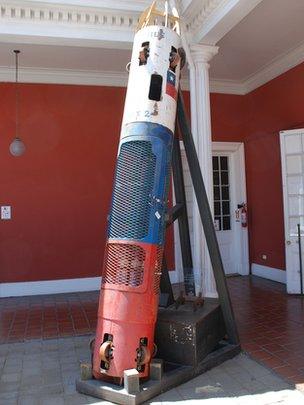
The 33 were pulled to safety in this narrow capsule
Then, a rescuers' drill broke through to an underground tunnel. When the rescue team pulled the drill out of the ground, there was a note attached to it.
"We are all OK in the refuge, the 33," it read.
The miners survived for a further seven weeks on food and water sent from above until they were finally hauled to the surface one by one in scenes watched by millions of TV viewers around the world.
At the time, great things were promised for Los 33 but the reality is starkly different.
Most are still seeing psychiatrists. Many are out of work or are cobbling together a living from part-time or temporary jobs.
One has been sectioned in a psychiatric clinic in the Chilean capital, Santiago, and at least two have had serious problems with drink and drugs.
And they have yet to receive any compensation from the mine owners.
Fear of the dark
"For the first two years after the accident I was fine," says Carlos Barrios, who was 27 at the time of the mine collapse. "I wasn't in any pain, I was playing football, I had a job and then: boom!"
Mr Barrios suffered a relapse. He had to quit his job at one of Chile's biggest copper mines and has been on sick leave for a year.
"I saw a psychiatrist but she just gave me pills. I became addicted and I'm still taking them," he told the BBC in Copiapo, the city closest to the mine.
"I have nightmares, a fear of the dark. I have a young daughter, and I can't sleep in the same bed as her and my wife because I have dreams and start thrashing about and lashing out at my own daughter.
Omar Reygadas, one of the oldest of the miners, has been without full-time mining work for nearly a year.

Omar Reygadas says it has been difficult to find jobs
Now 59, he says the miners' fame has counted against them: "Because of the accident we became well known. We've got contacts with the press, contacts with people in government.
"So if we're working for a company and we see that they're not doing things properly, they think we'll start knocking on doors. That's why companies are scared to give us work."
No compensation
In August 2013, a prosecutor closed an investigation into the mine collapse saying there were no grounds to prosecute the owners.
The decision angered both the miners and the government. Laurence Golborne, Chile's mining minister at the time of the accident, described it as "unbelievable".
He pointed out that the mine had no second exit tunnel, as obliged to by law, and that a chimney which could have been used as an escape shaft for the men had no ladder in it.

A modest monument has been erected at the entrance to the mine

Thirty-three flags, 32 from Chile, one for the sole Bolivian miner, stand on the hill where relatives waited for the miners to be rescued
Most of the miners are still pursuing a civil law suit against the owners and the state in the hope of winning compensation, but they recognise it could take years.
Alex Vega says he has lost "all faith" in the government for failing to honour its promises of help with their welfare and retraining.
All 33 were promised a pension, he says, but in the end only the 14 oldest miners were given one.
"They promised us dental treatment because we spent so long drinking water from the underground tanks that it rotted our teeth, but that came to nothing," he adds.
The government says there is a limit to what it can do. A private association is in charge of the miners' mental health and compensation is a matter for the courts.
Hollywood comes knocking
In a few months, a Hollywood film crew will come to Chile to shoot a movie about the men based on their testimony.

Some scenes for the film are already being shot in a salt mine in Colombia
It will reportedly star Antonio Banderas, Juliette Binoche and Martin Sheen.
The production company has promised the miners a cut of the box office receipts but that is unlikely to bring the men peace of mind.
Three years after their ordeal, Chile's 33 miners are not celebrities or millionaires as many had predicted.
In many cases, they are still wrestling with the trauma of what happened to them during those extraordinary days back in 2010.
You can hear Gideon Long's interviews with some of the miners on BBC Radio 4's PM programme on 22 January at 17:00 GMT
- Published1 August 2013
- Published13 October 2011
- Published11 October 2010